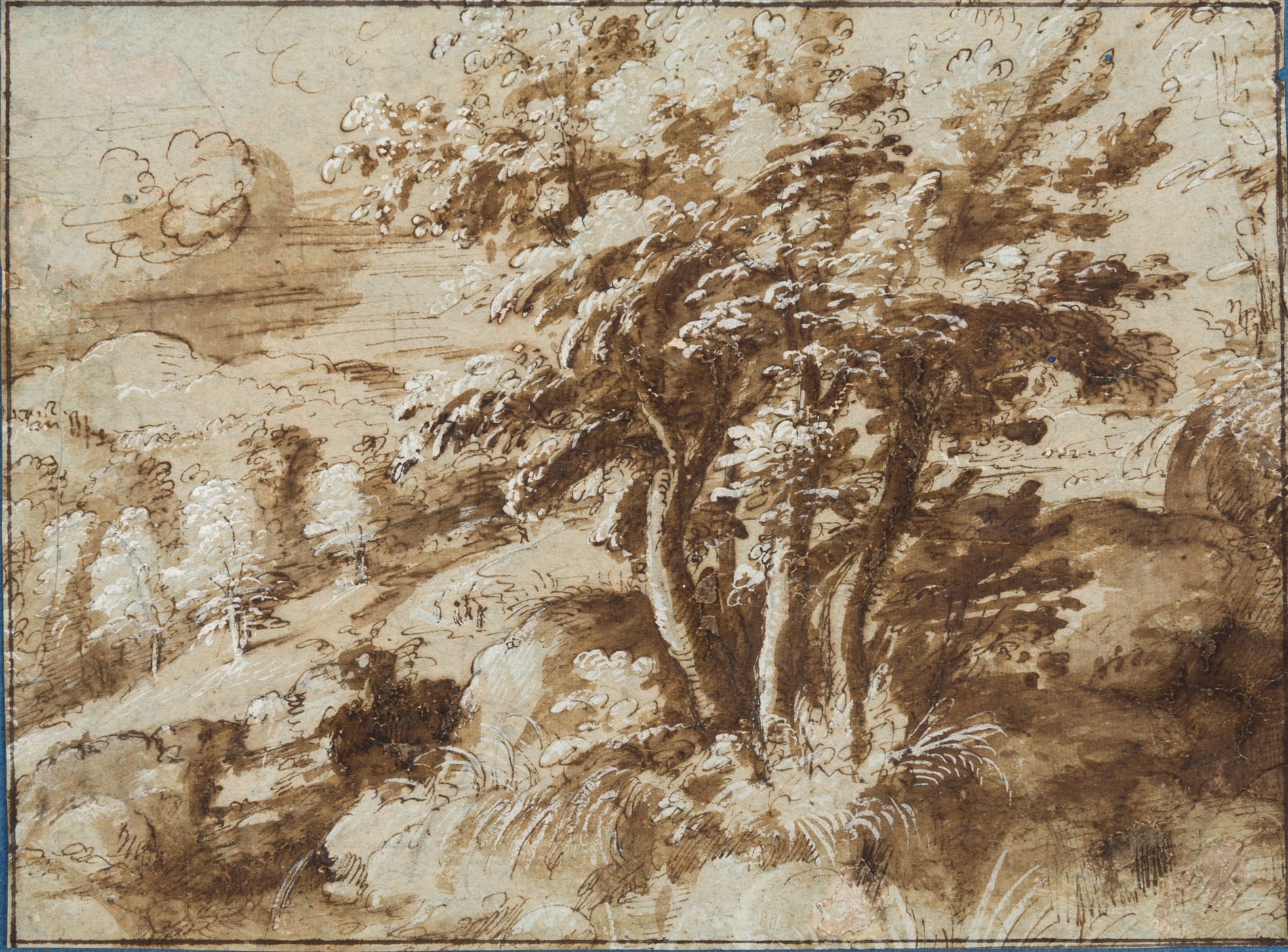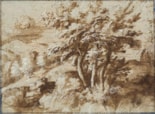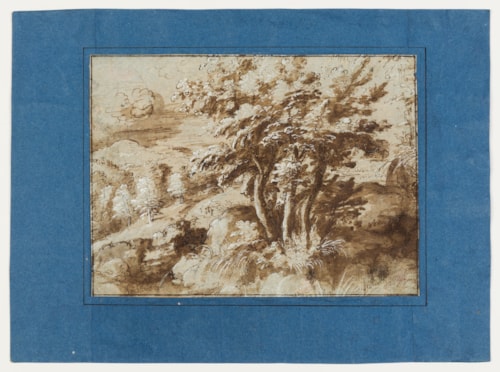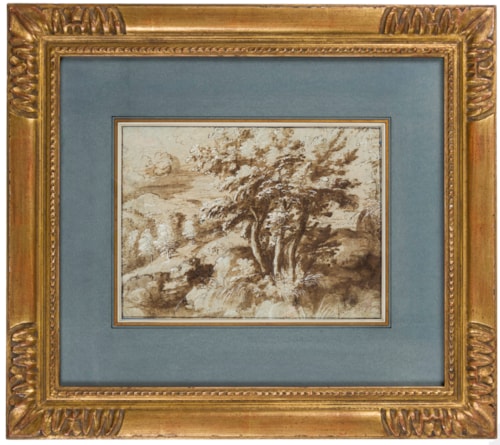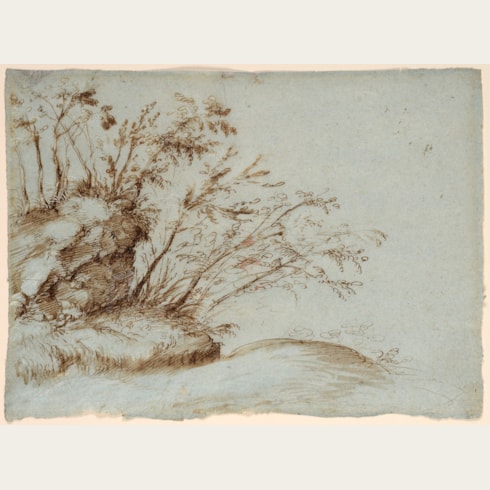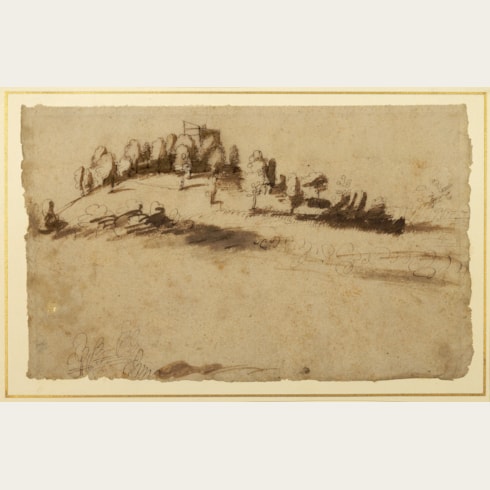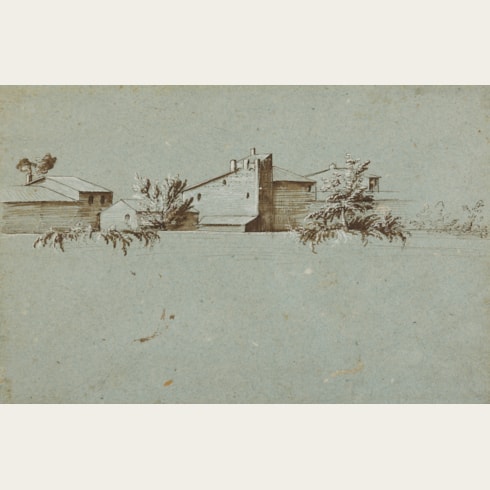Gherardo CIBO
(Genoa or Rome 1512 - Rocca Contrada 1600)
A Hilly Landscape with Trees
Laid down.
180 x 242 mm. (7 1/8 x 9 1/2 in.)
Around 360 landscape drawings by Cibo are known today, some of which bear dates ranging between 1560 and 1593. This hitherto unpublished drawing displays a more refined technique than most of the artist’s studies, and can be counted among his finest extant landscapes. Among stylistically comparable drawings by the artist is a Mountainous Landscape with an Arched Rock in the Uffizi and a Wooded River Landscape in the Musées Royaux des Beaux-Arts in Brussels, as well as a large mountain landscape in the Biblioteca Angelica in Rome.
The Cibo scholar Lucia Tongiorgi Tomasi notes that ‘Profound artistic sensibility, scientific knowledge and technical skill characterise the work of this notable sixteenth-century artist...Gherardo Cibo could also be considered as the very embodiment of that fascinating Renaissance ideal – the ‘artist-scientist-dilettante’. He was a precocious interpreter of the new and highly successful formula which was to unite the Italian and Flemish pictorial traditions.’ And, as another recent scholar has added, ‘That Cibo would eventually be regarded as one of the most delightful and original Italian landscapists of the sixteenth century is an unexpected reward for this gentil’huomo who never received classical training as an artist and who may well have regarded his activities as a landscape draftsman as little more than a pleasurable distraction.’
This drawing bears the drystamp of the 19th century Danish businessman and collector Benjamin Wolff (1790-1866). Wolff studied law in Copenhagen before settling in Calcutta, where for twelve years he worked for an English trading house, of which he eventually became a partner. He returned to Denmark a wealthy man in 1829, and the following year purchased the large manor home and estate of Engelholm, about sixty kilometres southwest of Copenhagen. An amateur draughtsman himself, Wolff assembled a collection of drawings by Danish and European artists ranging in date from the 16th century to the 19th century. Over the course of some thirty years, he acquired over 2,000 drawings, most of which were purchased at auctions in Denmark. Following the collector’s death in 1866, the drawings remained with his descendants for over 150 years. Apart from a modest bequest to the Statens Museum for Konst in Copenhagen in 1915 and a pair of exhibitions in a small town in Denmark in the early 1980s, in which the present sheet was included, Wolff’s collection of drawings has remained unpublished and little known to scholars.
The great-grandson of Pope Innocent VIII, and also related to the Della Rovere dukes of Urbino, Cibo was born into the Genoese aristocracy. He received a fine humanist education, studying in Rome and Bologna (the latter probably with the famous botanist Luca Ghini), and showed a talent for drawing from an early age. He seems to have briefly studied for the priesthood, before becoming a soldier and diplomat attached to the papal court in Rome. In 1540, aged just twenty-eight, Cibo appears to have retired from his papal duties and settled in the small town of Rocca Contrada (today called Arcevia), in the Apennines, where he lived for the next sixty years. As one scholar has noted, ‘In this peaceful haven he passed the remainder of his life, free to concentrate on his botanical and artistic pursuits: the painting of plants, trees and landscapes; the colouring and decoration of the images in important printed botanical texts; short excursions with friends into the neighboring countryside on collecting expeditions; and the preparation of medicaments based on herbs.’
Cibo dedicated the rest of his life to the study, collection and illustration of the plants and flowers of the Marchigian region, and became one of the foremost field botanists of his day. He travelled extensively around the Marche collecting specimens and corresponded with fellow naturalists throughout Italy, such as Ulisse Aldrovrandi. A gifted artist, despite his lack of any formal training, he produced a large number of colourful and scientifically accurate botanical illustrations. Among the botanical works illustrated by Cibo is an illuminated herbal now in the British Library in London, the pages of which depict plants, painted in tempera, set in expansive settings. These correspond closely to the landscape drawings of the so-called ‘Severino da Cingoli’ group, and it is from them that Nesselrath was able to correctly attribute the autonomous landscape drawings to Cibo. As the scholar further noted, ‘Partly because he was an engaging person, partly because he was intrigued by nature, Gherardo would perhaps never have called himself an artist. As a botanist he simply needed to document plants and natural phenomena with great accuracy in order to study and analyze them. In this field he was one of the most gifted draftsmen of all times and his skills were not inferior to those of trained artists…In his lively sketchbooks he spontaneously recorded views and landscapes, alternating these with rocks, plants, seeds, or pigment tests.’ Having lived most of his life in the relative isolation of Rocca Contrada, happily engaged in botanical studies purely for his own pleasure and enjoyment, Cibo died there in 1600, at the age of eighty-eight.
As a landscape draughtsman, Cibo worked mainly in the Marche; in the provinces of Ancona, Pesaro, Macerata and Perugia. His landscape drawings can be divided into two distinct types; views of actual sites in the Marche on the one hand and purely imaginary landscapes on the other. The drawings made on the spot are often inscribed with the location depicted and with astrological symbols to denote the specific day of the week. Such drawings are probably associated with the artist’s botanical studies, since they allowed him to record the precise places where his plant specimens were found, while also serving as a record of their natural habitat. Indeed, many of his botanical studies depict plants in their appropriate landscape settings.
While Cibo sent some drawings to family members and fellow botanists, most of his landscapes seem to have been done for his own pleasure. That he must have assembled his landscape drawings into albums, as he did with his botanical studies, is seen in an extract from a handwritten diary, written from 1553 onwards and now lost: ‘The cavalier Geronimo Ardoino came here to Rocca Contrada...and asked me if he could borrow my large volume of landscapes in pen and ink, which I lent him, having first removed certain sketches on bits of paper that were inside.’
Around 360 landscape drawings by Cibo are known today, some of which bear dates ranging between 1560 and 1593. Apart from the three albums of drawings in Jesi, significant groups of landscape sketches by the artist are in the Kupferstichkabinett in Berlin, the Szépmüvészeti Müzeum in Budapest, the Uffizi in Florence, the Biblioteca Civica ‘Passionei’ in Fossombrone, the Musée du Louvre in Paris, the Albertina in Vienna and the Staatliche Kunstsammlungen in Weimar. Smaller groups of drawings by Cibo are in the Kunstbibliothek in Berlin, the Kupferstichkabinett in Dresden, the Biblioteca Marucelliana in Florence, the Biblioteca Ambrosiana in Milan, the Pierpont Morgan Library in New York, the Hermitage in St. Petersburg, the Biblioteca Angelica in Rome and elsewhere. A sketchbook of landscape drawings by Cibo, numbering twenty-two sheets, appeared at auction in London in 1989 and is today in a private collection in France.
Provenance
Thence by descent in the Wolff-Sneedorf family until 2018.
Literature
Exhibition

